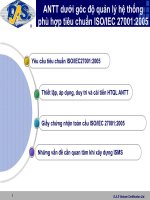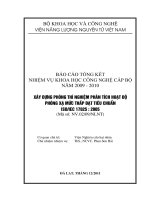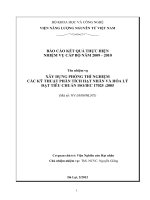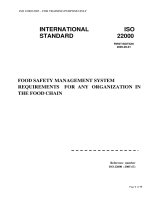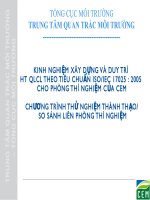Tiêu chuẩn iso 01920 4 2005
Bạn đang xem bản rút gọn của tài liệu. Xem và tải ngay bản đầy đủ của tài liệu tại đây (417.02 KB, 32 trang )
INTERNATIONAL
STANDARD
ISO
1920-4
First edition
2005-07-15
Testing of concrete —
Part 4:
Strength of hardened concrete
Essais du béton —
Partie 4: Résistance du béton durci
--`,,``,`-`-`,,`,,`,`,,`---
Reference number
ISO 1920-4:2005(E)
Copyright International Organization for Standardization
Reproduced by IHS under license with ISO
No reproduction or networking permitted without license from IHS
© ISO 2005
Not for Resale
ISO 1920-4:2005(E)
PDF disclaimer
This PDF file may contain embedded typefaces. In accordance with Adobe's licensing policy, this file may be printed or viewed but
shall not be edited unless the typefaces which are embedded are licensed to and installed on the computer performing the editing. In
downloading this file, parties accept therein the responsibility of not infringing Adobe's licensing policy. The ISO Central Secretariat
accepts no liability in this area.
Adobe is a trademark of Adobe Systems Incorporated.
Details of the software products used to create this PDF file can be found in the General Info relative to the file; the PDF-creation
parameters were optimized for printing. Every care has been taken to ensure that the file is suitable for use by ISO member bodies. In
the unlikely event that a problem relating to it is found, please inform the Central Secretariat at the address given below.
© ISO 2005
All rights reserved. Unless otherwise specified, no part of this publication may be reproduced or utilized in any form or by any means,
electronic or mechanical, including photocopying and microfilm, without permission in writing from either ISO at the address below or
ISO's member body in the country of the requester.
ISO copyright office
Case postale 56 • CH-1211 Geneva 20
Tel. + 41 22 749 01 11
Fax + 41 22 749 09 47
Web www.iso.org
Published in Switzerland
--`,,``,`-`-`,,`,,`,`,,`---
ii
Copyright International
Organization for Standardization
Reproduced by IHS under license with ISO
No reproduction or networking permitted without license from IHS
© ISO 2005 – All rights reserved
Not for Resale
ISO 1920-4:2005(E)
Contents
Page
Foreword............................................................................................................................................................ iv
Scope ..................................................................................................................................................... 1
2
Normative references ........................................................................................................................... 1
3
3.1
3.2
3.3
3.4
3.5
Determination of compressive strength............................................................................................. 1
Test specimens ..................................................................................................................................... 1
Apparatus .............................................................................................................................................. 2
Procedure .............................................................................................................................................. 2
Test results............................................................................................................................................ 6
Test report ............................................................................................................................................. 6
4
4.1
4.2
4.3
4.4
4.5
Determination of flexural strength ...................................................................................................... 6
Test specimens ..................................................................................................................................... 6
Apparatus .............................................................................................................................................. 6
Procedures ............................................................................................................................................ 8
Test results............................................................................................................................................ 9
Test report ........................................................................................................................................... 10
5
5.1
5.2
5.3
5.4
5.5
Determination of tensile splitting strength ...................................................................................... 10
Specimens ........................................................................................................................................... 10
Apparatus ............................................................................................................................................ 10
Procedure ............................................................................................................................................ 11
Test results.......................................................................................................................................... 13
Test report ........................................................................................................................................... 13
6
Test report ........................................................................................................................................... 14
--`,,``,`-`-`,,`,,`,`,,`---
1
Annex A (normative) Precision data for measurements of compressive strength................................... 15
Annex B (normative) Adjustment of test specimens for the compressive strength test ......................... 16
Annex C (informative) Examples of test reports ........................................................................................... 25
iii
© ISO 2005 – All rights reserved
Copyright International Organization for Standardization
Reproduced by IHS under license with ISO
No reproduction or networking permitted without license from IHS
Not for Resale
ISO 1920-4:2005(E)
Foreword
ISO (the International Organization for Standardization) is a worldwide federation of national standards bodies
(ISO member bodies). The work of preparing International Standards is normally carried out through ISO
technical committees. Each member body interested in a subject for which a technical committee has been
established has the right to be represented on that committee. International organizations, governmental and
non-governmental, in liaison with ISO, also take part in the work. ISO collaborates closely with the
International Electrotechnical Commission (IEC) on all matters of electrotechnical standardization.
International Standards are drafted in accordance with the rules given in the ISO/IEC Directives, Part 2.
The main task of technical committees is to prepare International Standards. Draft International Standards
adopted by the technical committees are circulated to the member bodies for voting. Publication as an
International Standard requires approval by at least 75 % of the member bodies casting a vote.
Attention is drawn to the possibility that some of the elements of this document may be the subject of patent
rights. ISO shall not be held responsible for identifying any or all such patent rights.
ISO 1920-4 was prepared by Technical Committee ISO/TC 71, Concrete, reinforced concrete and
pre-stressed concrete, Subcommittee SC 1, Test methods for concrete.
This first edition of ISO 1920-4:2005 cancels and replaces the first editions of ISO 4012:1978, ISO 4013:1978
and ISO 4108:1980, which have been technically revised.
ISO 1920 consists of the following parts, under the general title Testing of concrete:
Part 1: Sampling of fresh concrete
Part 2: Properties of fresh concrete 1)
Part 3: Making and curing test specimens
Part 4: Strength of hardened concrete
Part 5: Properties of hardened concrete other than strength
Part 6: Sampling, preparing and testing of concrete cores
Part 7: Non-destructive tests on hardened concrete
The following parts are under preparation:
Part 8: Determination of drying shrinkage of concrete
Part 9: Determination of creep of concrete
This series of Draft International standards was based on existing and draft ISO standards and on draft CEN
standards dealing with testing concrete.
1)
To be published.
--`,,``,`-`-`,,`,,`,`,,`---
iv
Copyright International Organization for Standardization
Reproduced by IHS under license with ISO
No reproduction or networking permitted without license from IHS
© ISO 2005 – All rights reserved
Not for Resale
INTERNATIONAL STANDARD
ISO 1920-4:2005(E)
Testing of concrete —
Part 4:
Strength of hardened concrete
1
Scope
This part of ISO 1920 specifies procedures for testing the strength of hardened concrete.
2
Normative references
The following referenced documents are essential for the application of this document. For dated references,
only the edition cited applies. For undated references, the latest edition of the referenced document (including
any amendments) applies.
ISO 48, Rubber, vulcanized or thermoplastic — Determination of hardness (hardness between 10 IRHD and
100 IRHD)
ISO 679, Methods of testing cement — Determination of strength
ISO 1920-3, Testing of concrete — Part 3: Making and curing test specimens
ISO 2781, Rubber, vulcanized — Determination of density
ISO 3310-1, Test Sieves — Technical requirements and testing — Part 1: Test sieves of metal wire cloth
ISO 4662, Rubber — Determination of rebound resilience of vulcanizates
EN 316:1999, Wood Fiberboards — Definition, Classification and Symbols
EN 12390-4:2000, Testing Hardened Concrete — Part 4: Compressive Strength — Specification for Testing
Machines
3
3.1
Determination of compressive strength
Test specimens
The test specimen shall be a cube or a cylinder meeting the requirements of ISO 1920-3 or cores meeting the
requirements of ISO 1920-6.
Damaged specimens shall not be tested.
Specimens that are badly honeycombed shall not be regarded as being representative of the quality of
concrete supplied. In general, standard cube and cylinder specimens should not be tested if they are badly
honeycombed as this is an indication of poor specimen making. When such specimens are tested, the test
report shall include the fact that the specimen was honeycombed.
1
--`,,``,`-`-`,,`,,`,`,,`---
© ISO 2005 – All rights reserved
Copyright International Organization for Standardization
Reproduced by IHS under license with ISO
No reproduction or networking permitted without license from IHS
Not for Resale
ISO 1920-4:2005(E)
Where the designated size, l1 or l2, of the cross-section is outside the tolerances, the specimens may be used
for testing by using the actual dimensions; see 3.4.
Where the dimensions or shape of a test specimen exceed the respective tolerances given in ISO 1920-3, the
specimen shall be rejected or adjusted (if feasible) by one or more of the following methods:
uneven surfaces levelled by grinding or by capping;
the deviation of angles corrected by cutting and/or grinding.
The procedures given in Annex B shall be used to adjust the specimen.
Adjustment by grinding shall be the reference method.
3.2
Apparatus
The test shall be carried out using a compression-testing machine conforming to EN 12390-4 or to a national
standard valid in the place of testing. The test machine shall be in calibration at the time of test. The
calibration shall be carried out at least once per year.
3.3
Procedure
3.3.1
Preparation and positioning of specimens
For specimens stored in water, excess moisture shall be wiped from the surface of the specimen before
placing in the testing machine.
--`,,``,`-`-`,,`,,`,`,,`---
The time between the extraction of the specimen from the humidity chamber or the water tank until the test
shall be as short as possible and not more than 3 h. During the time the specimen is outside the humidity
chamber or water tank, it shall be protected from drying, e.g. by covering with wet burlap.
All testing-machine bearing surfaces shall be wiped clean and any loose grit or other extraneous material
removed from the surfaces of the specimen that will be in contact with the platens.
Do not use packing, other than auxiliary platens or spacing blocks, between the specimen and the platens of
the testing machine.
Cube specimens shall be compressed perpendicularly to the direction of casting.
The specimen shall be centred on the lower platen to an accuracy of 1 % of the designated size of cubic, or
diameter of cylindrical specimens.
Where physical means of ensuring centring are provided on the testing machine and they are in calibration,
these shall be deemed to satisfy the requirements for accuracy of centring.
If auxiliary platens are used, the top auxiliary platen shall be aligned with the top of the specimen.
With two-column testing machines, cubic specimens should be placed with the trowelled surface facing a
column.
3.3.2
Loading
The load shall be applied without shock and shall be increased continuously at a constant rate until no greater
load can be sustained. Select a rate of stress not less than 0,15 MPa/s and not greater than 1,0 MPa/s.
When using manually controlled testing machines, any tendency for the selected rate of loading to decrease
as specimen failure is approached shall be corrected by appropriate adjustment of the controls.
2
Copyright International Organization for Standardization
Reproduced by IHS under license with ISO
No reproduction or networking permitted without license from IHS
© ISO 2005 – All rights reserved
Not for Resale
ISO 1920-4:2005(E)
When using automatically controlled testing machines, the rate of loading whilst testing concrete specimens in
compression shall be periodically checked to ensure that the rate is constant.
The maximum load indicated shall be recorded.
3.3.3
Assessment of type of failure
For cubic specimens, if the failure is satisfactory (see Figure 1), this fact shall be recorded. If the failure
pattern is unsatisfactory, this fact shall be recorded and the type of failure recorded using the pattern number
in Figure 2 closest to that observed.
For cylindrical specimens, if the failure is satisfactory (see Figure 3), this fact shall be recorded. If the failure
pattern is unsatisfactory, this fact shall be recorded and the type of failure recorded using the pattern letter in
Figure 4 closest to that observed.
NOTE
Unsatisfactory failures can be caused by insufficient attention to the detailed procedures for making, capping
and testing specimens or by a machine fault.
NOTE 1
All four exposed faces are cracked approximately equally, generally with little damage to faces in contact with
the platens.
NOTE 2
Figure 1 c) demonstrates explosive failure.
Figure 1 — Satisfactory failures of cube specimens
--`,,``,`-`-`,,`,,`,`,,`---
3
© ISOfor2005
– All rights reserved
Copyright International Organization
Standardization
Reproduced by IHS under license with ISO
No reproduction or networking permitted without license from IHS
Not for Resale
ISO 1920-4:2005(E)
Key
T
indicates a tensile crack
Figure 2 — Some unsatisfactory failures due to unequal cracking
of the exposed faces of cube specimens
Figure 3 — Satisfactory failure of cylinder specimen
--`,,``,`-`-`,,`,,`,`,,`---
4
Copyright International Organization for Standardization
Reproduced by IHS under license with ISO
No reproduction or networking permitted without license from IHS
© ISO 2005 – All rights reserved
Not for Resale
ISO 1920-4:2005(E)
--`,,``,`-`-`,,`,,`,`,,`---
Figure 4 — Some unsatisfactory failures of cylinder specimens
5
© ISO 2005 – All rights reserved
Copyright International Organization for Standardization
Reproduced by IHS under license with ISO
No reproduction or networking permitted without license from IHS
Not for Resale
ISO 1920-4:2005(E)
3.4
Test results
The compressive strength is given by the equation:
F
Ac
(1)
--`,,``,`-`-`,,`,,`,`,,`---
fc =
where
fc
is the compressive strength, expressed in megapascals;
F
is the maximum load, expressed in newtons
Ac
is the cross-sectional area, expressed in square millimetres, of the specimen on which the
compressive force acts.
If the actual dimensions of the test specimen are within ± 0,5 % of the designated size, the strength may be
calculated on the basis of the designated size. If the actual dimensions are outside this tolerance, the strength
calculation shall be based on the actual dimensions of the test specimen, determined in accordance with
ISO 1920-3.
The compressive strength shall be expressed to the nearest 0,5 MPa.
3.5
Test report
In addition to the requirements in Clause 6, the test report shall include the following:
type of specimen: cube, cylinder or core;
method of adjustment, if relevant;
compressive strength of specimen (to the nearest 0,5 MPa);
type of failure (satisfactory or unsatisfactory, and, if unsatisfactory, the nearest type).
4
Determination of flexural strength
4.1
Test specimens
The test specimen shall be a prism conforming to ISO 1920-3.
Sawn specimens of nominal width, l, of 100 mm or 150 mm with a square cross-section and overall length of
between 4l and 5l may also be tested to this part of ISO 1920. The ratio of l to the maximum size of aggregate
shall be not less than four, except for specimens with a nominal width of 150 mm and a maximum size of
aggregate of 40 mm, which may also be tested.
The direction of casting shall be identified on the specimen.
4.2
4.2.1
Apparatus
Testing machine
The test shall be carried out using a testing machine conforming to EN 12390-4:2000, 4.2 and 4.3, or to a
national standard valid in the place of testing.
6
Copyright International Organization for Standardization
Reproduced by IHS under license with ISO
No reproduction or networking permitted without license from IHS
© ISO 2005 – All rights reserved
Not for Resale
ISO 1920-4:2005(E)
4.2.2
Force application
The device for applying loads shall consist of two upper rollers and two lower rollers (see Figure 5).
All rollers shall be manufactured from steel and shall have a circular cross-section with a diameter between
20 mm and 40 mm and shall be at least 10 mm longer than the width of the test specimen.
Each roller, except one of the lower ones, shall be capable of rotating around its axis and of being inclined in a
plane normal to the longitudinal axis of the test specimen.
Key
1
2
loading roller (capable of rotation and of being inclined)
supporting roller
3
supporting roller (capable of rotation and of being inclined)
--`,,``,`-`-`,,`,,`,`,,`---
The distance, Lrol, between the lower (outer) rollers (i.e. the span) shall be equal to 3l, where l is the width of
the specimen. The distance between the upper (inner) rollers shall be equal to l. The inner rollers shall be
equally spaced between the outer rollers as shown in Figure 5. All rollers shall be adjusted in the positions
illustrated in Figure 5 to an accuracy of ± 2 mm.
Figure 5 — Arrangement for loading a test specimen (two-point loading)
7
© ISO 2005 – All rights reserved
Copyright International Organization for Standardization
Reproduced by IHS under license with ISO
No reproduction or networking permitted without license from IHS
Not for Resale
ISO 1920-4:2005(E)
4.3
Procedures
4.3.1
Preparation and positioning of specimens
The specimen shall be examined and any abnormalities shall be reported.
For specimens stored in water, excess moisture shall be wiped from the surface of the specimen before
placing in the testing machine.
The time between the extraction of the specimen from the humidity chamber or the water tank until the test
shall be as short as possible and not more than 3 h. During the time the specimen is outside the humidity
chamber or water tank, it shall be protected from drying, e.g. by covering with wet burlap.
All testing-machine bearing surfaces shall be wiped clean and any loose grit or other extraneous material
removed from the surfaces of the specimen that will be in contact with the rollers.
The test specimen shall be placed in the machine, correctly centred with the longitudinal axis of the specimen
at right angles to the longitudinal axis of the upper and lower rollers.
The reference direction of loading shall be perpendicular to the direction of casting of the specimen.
The test result may be affected by the direction of loading with respect to the direction of casting.
4.3.2
Loading
Do not apply the load until all loading and supporting rollers are resting evenly against the test specimen.
The load shall be applied without shock and shall be increased continuously at a constant rate until no greater
load can be sustained. Select a constant rate of stress of not less than 0,04 MPa/sec and not greater than
0,06 MPa/sec.
NOTE
FR =
The required loading rate on the testing machine is given by Equation (2):
s × l b × l h2
l rol
(2)
where
FR
is the required loading rate, expressed in newtons per second;
s
is stress rate, expressed in megapascals per second;
lb, lh
are the lateral dimensions (breadth and height), expressed in millimetres, of the specimen;
lrol
is the spacing, expressed in millimetres, of the lower rollers.
When using manually controlled testing machines, any tendency for the selected rate of loading to decrease,
as specimen failure is approached, shall be corrected by appropriate adjustment of the controls.
--`,,``,`-`-`,,`,,`,`,,`---
When using automatically controlled testing machines, the rate of loading shall be periodically checked to
ensure that the rate is constant.
The maximum load indicated shall be recorded.
8
Copyright International Organization for Standardization
Reproduced by IHS under license with ISO
No reproduction or networking permitted without license from IHS
© ISO 2005 – All rights reserved
Not for Resale
ISO 1920-4:2005(E)
4.3.3
Assessment of type of fracture
The fractured specimen shall be examined and the appearance of the concrete and type of fracture shall be
recorded (see Figure 6).
--`,,``,`-`-`,,`,,`,`,,`---
a) Satisfactory failure
b) Unsatisfactory failure
Key
1
loading points
2
3
fracture
supporting roller
Figure 6 — Types of fracture
A fracture outside the loading rollers (see Figure 6) shall be reported as unsatisfactory.
4.4
Test results
The flexural strength is given by Equation (3):
f cf =
F × l rol
(3)
l b × l h2
where
fcf
is the flexural strength, expressed in megapascals;
F
is the maximum load, expressed in newtons;
lb, lh
are the lateral dimensions (breadth and height), expressed in millimetres, of the specimen;
lrol
is the spacing, expressed in millimetres, of the lower rollers.
9
© ISO 2005 – All rights reserved
Copyright International Organization for Standardization
Reproduced by IHS under license with ISO
No reproduction or networking permitted without license from IHS
Not for Resale
ISO 1920-4:2005(E)
The flexural strength shall be expressed to the nearest 0,1 MPa.
4.5
Test report
In addition to the requirements in Clause 6, the test report shall include the following:
method of loading: two point/centre point;
flexural strength of specimen (to the nearest 0,1 MPa).
5
Determination of tensile splitting strength
5.1
Specimens
The specimen shall be a cube, cylinder or prism meeting the requirements of ISO 1920-3.
Damaged or badly honeycombed specimens shall not be tested.
5.2
Apparatus
5.2.1
Testing machine
The test shall be carried out using a machine conforming to EN 12390-4:2000, 4.2 and 4.3, or to a national
standard valid in the place of testing.
Dimensions in millimetres
Key
1
2
steel loading piece
hardboard packing
3
location where segment may be trimmed
Figure 7 — Curved loading piece
The machine shall be in calibration at the time of test.
10
Copyright International Organization for Standardization
Reproduced by IHS under license with ISO
No reproduction or networking permitted without license from IHS
© ISO 2005 – All rights reserved
Not for Resale
--`,,``,`-`-`,,`,,`,`,,`---
Curved steel loading pieces may be used in place of conventional plane platens when tests are carried out on
cubical or prismatic specimens (see Figure 7).
ISO 1920-4:2005(E)
5.2.2
Jig
A jig may be used for positioning the specimen and the packing strips (optional). The jig shall not restrict the
deformation of the specimen during the test.
A suitable jig for cylindrical specimens is shown in Figure 8.
5.2.3
Packing strips
Packing strips shall be of hardboard conforming to EN 316 or to a relevant standard valid in the place of use,
with a density > 900 kg/m3 and their use shall be the reference method.
NOTE
Results obtained with and without packing strips are not comparable.
Hardboard packing strips shall be used only once.
Packing strips shall have the following dimensions:
= 10 mm ± 1mm;
width, la
thickness, lth = 4 mm ± 1mm;
length, llc
greater than the length of the line of contact of the test specimen.
Key
1
steel loading piece strips
2
hardboard packing
Figure 8 — Jig for testing cylindrical specimens
5.3
Procedure
5.3.1
5.3.1.1
Preparation of the specimen
Marking
--`,,``,`-`-`,,`,,`,`,,`---
The direction of casting shall be identified on the specimen.
For cylindrical specimens, two lines shall be marked along which the load is to be applied. Unless a centring
jig is used, these lines shall be opposite to each other in an axial plane.
11
© ISO 2005 – All rights reserved
Copyright International Organization for Standardization
Reproduced by IHS under license with ISO
No reproduction or networking permitted without license from IHS
Not for Resale
ISO 1920-4:2005(E)
For cubic and prismatic specimens, the lines shall be marked on the moulded faces so that the fracture plane
will cross the trowelled face, or the upper face as cast (see Figure 9).
The extremities of the two lines shall be connected over each end of the specimen, so as to define clearly the
plane of loading.
Cleaning
For specimens stored in water, any excess moisture shall be wiped from the surface of the specimen before
placing in the testing machine.
The bearing surfaces of the jig, packing strips, loading pieces and platens shall be wiped clean and any loose
grit or other extraneous material removed from the surface of the specimen that will be in contact with the
packing strips.
5.3.2
Specimen positioning
The test specimen shall be placed centrally in the testing machine, optionally using a jig. Packing strips and
loading pieces, if required, shall be carefully positioned along the top and bottom of the plane of loading of the
specimen.
With cylindrical specimens, care shall be taken to ensure that the upper platen is parallel with the lower platen
during loading.
5.3.3
Loading
Ensure that cylindrical specimens remain centred when the load is first applied, either by means of a jig or by
temporary supports.
The load shall be applied without shock and shall be increased continuously at a constant rate until no greater
load can be sustained. The rate of stress increase(s) shall be not less than 0,04 MPa/s and not greater than
0,06 MPa/s.
NOTE
The required loading rate on the testing machine is given by Equation (4):
FR =
s × π× L×l
2
(4)
where
FR
is the rate of increase of load, expressed in newtons per second;
L
is the length, expressed in millimetres, of the specimen;
l
is the designated dimension, expressed in millimetres, of the specimen;
s
is the increase, expressed in megapascals per second, in rate of stress.
When using manually controlled testing machines, any tendency for the selected rate of loading to decrease,
as specimen failure is approached shall be corrected by appropriate adjustment of the controls.
When using automatically controlled testing machines, the rate of loading shall be periodically checked to
ensure that the rate is constant.
The maximum load indicated shall be recorded.
12
Copyright International Organization for Standardization
Reproduced by IHS under license with ISO
No reproduction or networking permitted without license from IHS
© ISO 2005 – All rights reserved
Not for Resale
--`,,``,`-`-`,,`,,`,`,,`---
5.3.1.2
ISO 1920-4:2005(E)
5.3.4
Examination of specimen
The fractured specimen shall be examined and the appearance of the concrete and type of fracture, if
unusual, shall be recorded (see Figure 9). An example of unusual type of fracture is when the plane of fracture
is not vertical.
--`,,``,`-`-`,,`,,`,`,,`---
Key
1
2
plane of loading
trowelled surface
Figure 9 — Plane of loading
5.4
Test results
The tensile splitting strength is given by Equation (5):
f ct =
2F
π× L×l
(5)
where
fct
is the tensile splitting strength, expressed in megapascals;
F
is the maximum load, expressed in newtons;
L
is the length, expressed in millimetres, of the line of contact with the specimen;
l
is the designated cross-sectional dimension, expressed in millimetres.
For deviations from the standard method with respect of the dimensions of the specimen, the strength
calculation may be based on the actual dimensions of the test specimen.
The tensile splitting strength shall be expressed to the nearest 0,05 MPa.
5.5
Test report
In addition to the requirements in Clause 6, the test report shall include the following:
description of loading pieces (if appropriate)
tensile splitting strength of specimen (to the nearest 0,05 MPa).
13
© ISO 2005 – All rights reserved
Copyright International Organization for Standardization
Reproduced by IHS under license with ISO
No reproduction or networking permitted without license from IHS
Not for Resale
ISO 1920-4:2005(E)
6
Test report
In addition to the requirements for each test method, the report shall include the following:
a)
identification of the test specimen;
b)
location of performance of test;
c)
time and date of test;
d)
dimensions of the specimen (actual or checked designated);
e)
mass of specimen and apparent density (optional);
f)
checks on shape and flatness of specimen, including cross-sectional area, expressed in millimetres (if
appropriate);
g)
details of adjustment by grinding (if appropriate);
h)
condition of specimen at receipt for storage (if appropriate);
i)
surface moisture condition of specimen at time of test (saturated/moist);
j)
age of specimen at time of test (if known);
k)
maximum load, expressed in kilonewtons, at fracture;
l)
appearance of the concrete (if unusual);
m) location of fracture (if appropriate);
appearance of fracture surface (if unusual);
o)
deviations from the standard method of testing;
p)
a declaration from the person technically responsible for the test that the testing was carried out in
accordance with ISO 1920-4 except as noted in 6 o).
--`,,``,`-`-`,,`,,`,`,,`---
n)
14
Copyright International Organization for Standardization
Reproduced by IHS under license with ISO
No reproduction or networking permitted without license from IHS
© ISO 2005 – All rights reserved
Not for Resale
ISO 1920-4:2005(E)
Annex A
(normative)
Precision data for measurements of compressive strength
Tables A.1 and A.2 give the precision data.
Table A.1 — Precision data a for measurements of the compressive strength of hardened concrete
--`,,``,`-`-`,,`,,`,`,,`---
Sample shape and size
mm
Repeatability conditions b
Reproducibility conditions c
sr
%
r
%
sR
%
R
%
cube, 100
3,2
9,0
5,4
15,1
cube, 150
3,2
9,0
4,7
13,2
NOTE
For additional information on precision, and for definitions of the statistical terms used in connection with precision, see
ISO 5725 (all parts).
a
The precision data includes the procedures of sampling, specimen making, curing and testing of compression strength. Values are
expressed as percentages of the mean of the two cube strengths whose difference is to be compared with r or R.
b
The difference between two test results from the same sample by one operator using the same apparatus within the shortest
feasible time interval will exceed the repeatability value r on average not more than once in 20 cases in the normal and correct
operation of the method.
c
Test results on the same sample obtained within the shortest feasible time interval by two operators each using their own
apparatus will differ by the reproducibility value R on average not more than once in 20 cases in the normal and correct operation of the
method.
Table A.2 — Precision data a for measurements of the compressive strength of hardened concrete
Sample shape and size
mm
cylinder, 150 (diameter) by
300 (height)
NOTE
a
Repeatability conditions
Reproducibility conditions
sr
%
r
%
sR
%
R
%
2,9
8,0
3,1
11,7
The precision data only includes the procedure of testing for compressive strength.
Values are expressed as percentages of the mean of the three cylinder strengths whose difference is to be compared with r or R.
15
© ISO 2005 – All rights reserved
Copyright International Organization for Standardization
Reproduced by IHS under license with ISO
No reproduction or networking permitted without license from IHS
Not for Resale
ISO 1920-4:2005(E)
Annex B
(normative)
Adjustment of test specimens for the compressive strength test
B.1 General
When it is necessary to adjust the size of the specimen, it shall be ground or sawn perpendicular to its
longitudinal axis.
The intended load-bearing surfaces shall be prepared by grinding or by capping to improve the contact with
the loading machine.
Cutting and grinding shall be carried out in such a way that structural changes of the test specimen are
avoided.
Various capping materials and the maximum compressive strength that are suitable are shown in Table B.1.
Table B.1 — Restrictions on methods of adjustment
Restriction based on (anticipated) measured strength
MPa
Method
Grinding
Calcium aluminate cement
unlimited
mortar a
up to 50
Calcium aluminate cement paste
up to 60
Sulfur mixture
up to 50
High-strength sulfur mixture
up to 100
Sandbox
up to 100
Elastomeric pad
up to 80
a
B.2 Grinding
Specimens cured in water shall be removed from the water for grinding for not more than 1 h at a time and
re-immersed in water for at least 1 h before further grinding or testing.
The ends of the specimen shall be ground to the tolerances set out in ISO 1920-3
B.3 Capping — Calcium aluminate cement mortar or cement paste method
B.3.1 General
These methods shall be used only for capping cylindrical concrete test specimens.
Before capping, ensure that the surface of the specimen is in a wet condition, is clean and all loose particles
removed.
The caps shall be as thin as possible and shall not, on average, be greater than 5 mm thick: small local
deviations are permissible.
16
Copyright International Organization for Standardization
Reproduced by IHS under license with ISO
No reproduction or networking permitted without license from IHS
© ISO 2005 – All rights reserved
Not for Resale
--`,,``,`-`-`,,`,,`,`,,`---
Other cements may be used provided that, at the time of test, the mortar has a strength at least equal to the
anticipated strength of the concrete.

